| Abelmoschus manihot-Sunset
hibiscus. Family: Malvaceae. Annual or short lived perrenial.
Pale yellow flowers with a maroon center. In areas with mild frost
plants may come back from the roots. Deeply lobes leaves.
|
| Abelmoschus moschatus- Musk Mallow. Family: Malvaceae.Seeds
are used as a flavoring agent. Large velvety leaves. Pale yellow
flowers with maroon center. Blooms the 1st year from seed. May be a short lived perrenial in mild areas.
|
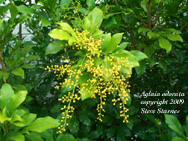 |
Aglaia odorata- Family: Meliaceae. Tropical shrub with fragrant tiny yellow flowers. Glossy deep green leaves.
Unique fragrance. Flowers are used to scent tea. Fairly easy to grow. Once established in the tropics, it requires little care. Good in large container.
Full sun to light shade. Slightly acidic soil high in organic matter. Cuttings are a bit difficult to root but I will have this in production periodically.
|
| Artabotrys hexapetalus- Annonaceae.
This species has previously been classified as A. uncinatus and A. odoratissimus.
Tropical Asia. This species is really a shrub in our experience. May be some plants have a
more vine-like habit. Glossy green leaves. Tolerates
full sun to medium shade. Grows best if temperatures are above 45
degrees F. .
|
| Azadirachta indica- Neem tree. Meliaceae.
Small to medium tree native to India. Monopinnate leaves, brown bark.
Panicles of white fragrant flowers. Used in ayurvedic medicine.
Seed oil is used as a natural insecticide. Seeds have very
short viability and my plants rarely set seed. Good seed production is obtained in hot slightly dry conditions. It seems that the windward side
of the Big Island is a bit too cool and wet for seed production.
|
| Barringtonia asiatica- Family: Lecythidaceae. Large tree native to coastal areas of tropical Pacific
islands. Leathery oval leaves about 6 to 8 inches long. Typically found in coastal areas. Large 4 angled seeds are poisonous. Full Sun. Sandy Soil. Salt tolerant.
Once established growth is moderate to fast. Seems to be better at lower elevations in Hawaii.
|
| Bauhinia galpinii- (B. punctata)- Fabaceae. Common Name: Red orchid
tree. Large shrub hardy to 18-20 degrees F. Orange or red flowers.
Native to Africa. Very ornamental. Grows well in containers.
Full sun. Seeds germinate in 3-12 days. Growth is moderate to fast
during the summer.
|
| Bauhinia hookeri- Fabaceae. Common Name: Mountain ebony.
Native of Northeastern Australia. Medium tree with white
flowers and red stamens. Bifid leaves are small. Hardy outdoors in zone 10 & 11. Slow growing when small.
Makes a good container specimen or bonsai.
|
| Bauhinia purpurea- Purple orchid tree.
Will take slight frost. Large shrub to small tree. Native to Southeast
Asia. Very attractive when in bloom. Germinates rapidly in 3-8 days.
Growth is moderate to rapid in warm weather.
|
| Bauhinia racemosa- Burmese silk orchid.
Small tree with yellow flowers. Native of Northern India and Burma.
Another species well worth growing. Germination is erratic.
Frost damage occurs at 26-28 degrees F.
|
| Bauhinia retusa- Bight yellow
flowers. Unusual leaf shape. New growth has a hint of red or
bronze. Seeds germinate rapidly in 3-8 days. Growth is slow
to moderate to rapid in warm weather. Not commonly grown in the US.
Minor frost damage occurs at 26-27 degrees F.
|
| Bauhinia sp.- This species came to us mislabeled as B. hookeri. It may
be B. monandra. Very nice pink fragrant flowers in the fall. Blooms in about 2.5 years from seed. Relatively
fast growing. Full sun. Tolerates some cool temperatures. I'm not sure how frost tolerant this one
may be. Seeds harvested this spring from our trees.
|
| Bauhinia tomentosa- Large shrub with
yellow flowers. Native to India and China. Out of stock.
|
| Bolusanthus speciosus- African tree
wisteria. Small slow growing tree. Racemes of purple flowers.
Small seedlings have survived a number of nights at 33-35 degrees F with
no damage. Pinnate leaves.
|

| Brownea angustifolia- Family: Fabaceae. Native . Medium tree with large pinnate leaves.
Leaves are lanceolate. New growth is soft and pendant. It emerges a pale green. Best with some shade and protection from wind. Plants
can tolerate full sun but will not look their best if it is a windy area.
Slightly acid soil. My plant gets chelated iron and magnesium about once a month. Keep moist. Not drought tolerant. Large clusters
of bright red blooms. My plant began to bloom at about 7 ft. tall.
|

| Brownea lorentensis- Family: Fabaceae. Appears to be a synonym for B. grandis.
Large clusters of red flowers. Native to the Amazon basin. Medium tree with large pinnate leaves.
Leaflets are lanceolate. New growth is soft and pendant. It emerges a pale mauve color. Best with some shade when young.
Slightly acid soil. My plant gets chelated iron and magnesium about 3 to 6 times per year. Keep moist. Not drought tolerant. 1st blooms
appeared when the tree was about 9 or 10 ft. tall and between 4 and 5 years old.
|
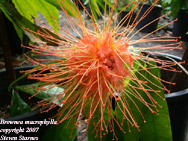
| Brownea macrophylla- Family: Fabaceae. Small tree with pinnate leaves;long lanceolate leaflets.
Native to tropical rainforest of South America. Red or Peach colored blooms. Best in areas protected from wind. Keep moist.
Outdoors in Zones 10B to 11. Keep moist. Light shade to full sun. Slightly acid soil. My largest plant blooomed in a 5 gallon pot.
|
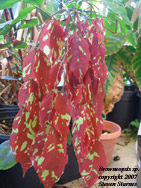 |
Browneopsis sp.- Family: Fabaceae. Similar to Browneopsis ucayalina. Native to tropical
rainforest of South America. The seeds are smaller
than B. ucayalina and the plant is much slower growing. New foliage is pendant and mottled pale green/maroon. Mature leaves are
medium to dark green. Slightly acid soil high
in organic matter. Keep moist and warm. Plants need an area protected from wind. I use chelated iron and magnesium on my plant about once a month.
|
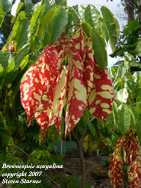 |
Browneopsis ucayalina- Family: Fabaceae. Native to tropical rainforest of Ecuador.
Pinnate leaves are pendant and mottled with medium green/maroon markings; camoflage appearance. As growth matures
it becomes stiff, straightens up and gradually turns to medium green. Slightly acid soil. Medium shade to full sun. Must be protected from wind or
the new growth will suffer wind burn. Likes to be kept moist.
|
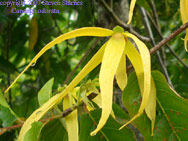
| Cananga odorata- ylang-ylang. Annonaceae.
Tropical tree famous for its highly fragrant flowers. Fragrance is strongest during hot afternoons and just after sunset. Leaves are oblong
to ovate. Growth rate is moderate when small. Germination can be slow and erratic.
Begins to bloom when about 2.5 to 3 years old. My plants begin to bloom when 7 to 8 ft. tall.
|

| Carissa macrocarpa- Apocynaceae. Common name: natal plum. Shrub with very glossy round to oval leaves.
White fragrant flowers are followed by red edible fruit. Widely planted as a hedge or ornamental in the tropics and warmer regions of the subtropics.
Frost tolerant to about 26 F. Full sun. Drought tolerant once established. Good canditdate for bonsai. Outdoors in Zones 9b to 11.
|
| Cassia alata-Common Name: candle bush. Shrub with
erect inflorescence of yellow flowers. Germination begins in 3-4
days and continues for 2 weeks. Grows rapidly in hot weather.
Good Container plant. Invasive in some areas.
|
| Cassia grandis- Famlily: Fabaceae. Common Name: Pink Shower Tree. Ornamental tree with
pink blooms. Striking when in full bloom. Good quality hard wood. New growth is bronze. Medium sized tree native to southeast Asia.
Full sun. Keep moist for most rapid growth.
|
| Cochlospermum vitifolium-wild cotton tree.
Cochlospermaceae. Small to medium tree native to Mexico and Central America.
Bright orange-yellow flowers. Very showy.
|
|
Copaifera langsdorfii- Family: Fabaceae. Common Names: Diesel tree, copaiba. Trees are tapped for
hydrocarbon rich sap that can used as a diesel substitute with apparently minimal processing. Also, used to produce lacquers. Also,
resin is reported to have a number of medicinal uses.
Native to tropical forest of Brazil. It is not reported to be cold tolerant and can only be grown in the tropics. Growth rates
are moderate in young plants. Ultimate height is reported to range from 6 to 35 meters; it likely depends on soil and growing conditions.
|
| Dillenia indica-. Dilliniaceae. Common name: elephant apple.
Great as an ornamental container plant. Native Indian fruit on medium size tree. Fruits are 3 inches in diameter and
used in drinks, chutney's and curries.
Tropical requirements. Attractive long leaves with serrated edge.
Very large white flowers. Germination begins in 4-5 weeks and continues sporadically for 2 or 3 months.
Growth rate is slow to moderate. Full sun. Drought tolerant once established. Outdoors in Zones 10 to 11.
|
| Eleocarpus sphaericus-
Eleocarpaceae. Common name: rudraksha. Native to India. Large ornamental tree with an open canopy. Seeds are
ornamental and used in Hindu rosaries. Seems to grow with little care in Hawai'i. In my experience seeds have been difficult
to germinate. Once established growth is fast. Full sun. Drought tolerant once established.
|
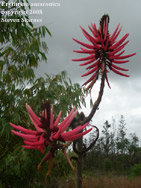 |
Erythrina amazonica-Family: Fabaceae. Small tree with hot pink blooms native to the Amazon basin.
Deep green leaves are only briefly deciduous. In Hawaii it is evergreen or nearly so. Seems to be somewhat resistant to the gall
wasp that has damaged many other Erythrina species in Hawaii. Full sun. Keep moist. Outdoors in Zones 10B to 11. I don't expect
this species to have much tolerance for cool or cold weather. Probably best where temperatures remain above 55F for most of the
year.
|
| Erythrina humeana- Fabaceae. Large
shrub. Native to coastal regions of South Africa. Scarlet flowers
and red seeds. Begins blooming at about 1.5 years old. Don't over water in the winter. Prefers to be
kept a bit dry when temperatures are cool. Germination can be erratic taking
several months. Suseptible to scale and an introduced gall wasp. I've stopped growing this species.
|
| Erythrina indica( E. variegata)-
Indian Coral Tree. Fabaceae. Vigorous grower with scarlet
flowers in racemes up to 6 inches long. Spectacular in bloom. In Hawai'i we get 4 to 6 feet of
growth each year. Our plants bloomed when just 1 year old and 5 to 6 feet tall. Doesn't tolerate hard freezes.
I have broken a seedling in half and the plant survived and quickly recovered.
It is a tough plant as long as you don't let it freeze. This plant has been very suseptible to an introduced gall wasp.
So I've stopped growing this species.
|
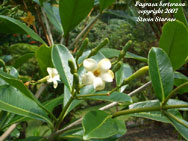 |
Fagraea berterana- Common Name: Puakenekene. Native to tropical Pacific Islands. This large shrub to
small tree has dark green glossy thick leaves. Nicely fragrant flowers open white and turn orange with age. Popular lei flower. Full sun.
Drought tolerant once established. Tolerates some wind. I doubt that this plant has much tolerance to cool or cold temperatures.
USDA Zones 10B to 11.
|
| Ficus abutilifolia-Moraceae.
Shrub or small tree. Smooth light bark and very large round
leaves. Native to tropical Africa. Zone
10 outdoors. Full sun or light shade.Young plants grow slowly. Thick truncks
develop on relatively young plants. Excellent container plant with
good bonsai potential.
|
|
Ficus benghalensis- Family: Moraceae. Common name: Indian Banyan. Large tree develops many aerial roots
that thicken to form additional trunks. Ovate leaves about 6 or 7 inches long. Planted near temples in India. Can be used for
bonsai. Even small plants 1 to 2 ft. tall put out aerial roots from the trunk.
|
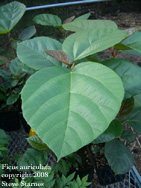 |
Ficus auriculata- Moraceae. Native to Southern China. Ripe fruit and young leaves are reported to be
edible. Large ornamental leaves. This large tree is a striking gardens specimen. Can be trimmed to maintain a smaller size.
I will have plants ready to ship in the fall of 2008. Probably a few ready in October and more in November. Not sure how much
frost this can take. But since it grows at elevations up to 3,000 ft. in Yunnan, I would assume that it can tolerate light
frost. Outdoors in Zones 10 to 11. Plants are available starting in October, 2008.
|
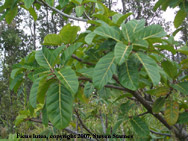 |
Ficus lutea-Moraceae.
Medium tree. Smooth light bark and oblong leaves with yellow veins.
New buds are reddish and when the tree is flushing with new growth it is showy. Native to tropical Africa. Full sun or light shade.
Drought tolerant. Young plants grow slowly. Zone 10 outdoors. Thick truncks
are already developing on our plants. Excellent container plant with
good bonsai potential.
|
|
Ficus religiosa-Family: Moraceae. Common Names: Bohdi tree, Bo tree or Sacred Fig.
Fig native to India. The Buddha reached enlightenment will meditating in the shade of this tree. Unique
leaves. Good for bonsai. Can be maintained in a container for many years. This species produces zero to few aerial roots.
|
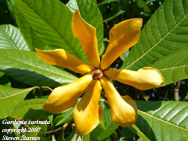 |
Gardenia carinata Tree gardenia. Rubiaceae.
Native of Southeast Asia. Small Tree. Oval medium green leaves about 8 inches long.
Young plants may be slow growing. Large
showy fragrant flowers. Flowers are white when they open but slowly change to orange.
|
| Gardenia thunbergia- South African
Gardenia. Rubiaceae. large white fragrant flowers. Glossy
green leaves Grown in southern California and in the deep south.
Some cold damage occurs at 26-27 degrees F. Germination begins in
4-5 weeks.
|
| Gardenia volkensii- Rubiaceae. Large shrub to small
tree native to tropical Africa. Glosy green obovate leaves. Large
white fragrant flowers in the spring and summer.
Can be fast growing in warm areas. Seeds germinate easily in 2-4 weeks
at 80-90 degrees. Zone 10. Minor cold damage occurs at 28 degrees
F.
|
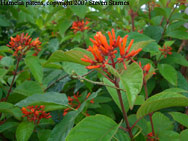 | Hamelia patens- Family: Rubiaceae. Common Name: Fire cracker bush. Large shrub to small tree native
to tropical South America. Clusters of bright red flowers. Blooms throughout the year. Small black berries with very small seeds. The berries are edible and medicinal.
Prune to maintain a smaller size if desired. Vigorous plants are easy to grow. Full sun. Fertilize lightly once or twice a year. Mulch to maintain moisture during
dry periods. Requires little care and tolerates neglect. May be invasive in wet rainforest climates.
|
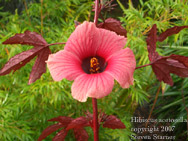 |
Hibiscus acetosella- Family: Malvaceae. Common Name: False Roselle.
Native to tropical Africa. Large shrub with deep red leaves. Flowers are reddish and don't contrast much with the foliage. The attractive foliage
stands out agains greens or variegated plants. The young leaves are edible. Full sun. Good container plant
|
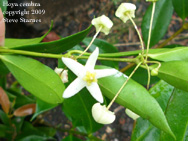 |
Hoya cembra- Aclepidaceae. This Hoya forms a samll shrub with arching branches. 1 inch white flowers
are nicely fragrant; clean citrus scent with hints of jasmine. Grows well with light shade. Rich well drained slightly acid soil. Excellent
container plant. Easy to grow and blooms when small. Blooms several times per year in the tropics.
|
| Hymnenosporum flavum Australian native
in the Pittosporaceae. Masses of strongly fragrant yellow flowers.
Large shrub. Should do well in containers. I'm not sure how much cold it can take. Our plants tolerated several moderate
frost with no damage. Probably takes
temperatures aroun 24F with no damage.
|
| Leucaena leucephala - Fast growing tropical
legume. Fabaceae. Used for reforestation in the tropics. Mimosa like
blooms. I have had Leucaena seedlings that survived a 27 degree freeze.
|
| Markhamia hildebrandtii- Bignoniaceae.Funnel
shaped yellow flowers in panicles. Native to east Africa. Small
tree with glossy pinnate leave; each leaflet is serrated.. Germination
is rapid. Growth rate is moderate during the first year. Good potential
for containers. Zone 10.
|
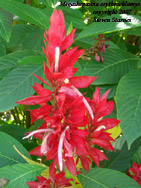 |
Megaskepasma erythrochlamys- Acanthaceae. Common Name: Brazilian Red Cloak. Large shrub with
bright red bracts. Blooms all year. Full Sun. Easy to grow. Needs little care once established. USDa Zones 10B to 11.
|
| Mesua ferrea- Clusiaceae. Common Names: nag champa, Indian ironwood. medium tree native
to Asia. Fragrant flowers about 2 inches in diameter with white petals and a dense ring of bright yellow stamens. Begins to bloom at about 5 ft. tall. New leaves are deep blood red. Young plants grow slowly.
Best with some shade when small. Prefers a rich soil high in organic matter. But it will grow in rocky areas as well. Has medicinal uses.
also.
|
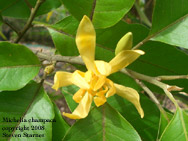 |
Michelia champaca- Family: Magnoliaceae. Common Names: champa. Fragrant gold or orange flowers
are born in abundance during the summer. This medium to large tree is native to northern Indian. I have 2 color variants; orange and yellow.
The tree with orange flowers blooms and seems to be a semi-dwarf (unfortunately no seed from this one). Full sun. Rich slightly acid soil high in organic matter.
I apply K-Mag 2 or 3 times a year; it seems to promote blooming. Zones 9B to 11.
|
|
Nyctanthes arbor-tristis- Oleaceae. Common Name: Parijat, Night Jasmine, Tree of Sadness. Large shrub to
small tree. Rough textured deep green leaves. Fragrant orange and white flowers open at night. Easy to grow and vigorous. Full sun. Keep moist
Blooms several times per year in Hawaii. Most abundant blooms occur late spring through fall. Outdoors in Zones 10 to 11.
|
|
Oroxylum indicum- Bignoniaceae. Common Name: Indian trumpet tree.
Native to eastern India. Trumpet shaped flowers. Deep green pinnate leaves.
The pods are eaten and maybe the young leaves.
Seeds are very flat larger than a quarter in diameter. Barely cover the seeds and keeping very moist.
Germination is fast (7 to 12 days).
|
|
Palicourea guianensis- Rubiaceae. Common name: unknown. Shrub native to
tropical South America. Leaves are a dark velvety green. Bright yellow and red inflorescence. Very ornamental.
Rare in cultivation. I have a big batch of seedlings that will be ready to ship late 2009 or early 2010.
|
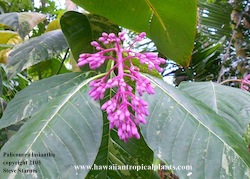 |
Palicourea lasiantha- Family: Rubiaceae. Clusters of bright purple flowers. Large deep green leaves. Light to medium shade.
Must be kept moist or it will wilt on hot days. Relatively fast growing once established. Good in large containers. Begins to bloom at about
4.5 to 5 ft. tall.
|
| Parkinsonia aculeata- Jerusalem Thorn.
Fabaceae. Tropical legume. Shrub or small tree. 1 inch yellow
flowers in large racemes. Native to tropical America. Worth
trying in container in cold regions. Rapid germination at 80-90 degrees
F. Fast growing. Survives frost of 26-27 degrees F with little or no damage.
|
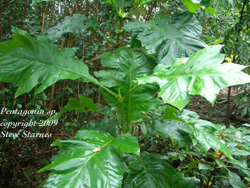
|
Pentagonia species- Family: Rubiaceae. Small to medium shrub with ornamental large lobed leaves bewtween
2 and 2.5 ft. long. Tubular flowers are densely clustered around each node. The leaves are the most striking
feature of this plant. Best with some afternoon shade. Easy to grow in the tropics. Good potential as an indoor plant. Rare in cultivation.
Native to South America. Outdoors in Zones 10B to 11 or indoors. I don't expect this species to have much cold tolerance.
|
| Pseudobombax ellipticum- Shaving brush
tree. Bombacaceae. Ornamental tree cultivated in zone 9&10.
Large ornamental flowers. Very attractive tree.
|
| Pterospermum acerifoium- Kanak-champa. Sterculiaceae. Medium
tree with with large cordate or round leaves Large fragrant flowers are produced in April - May. Some parts of the plant are used medicinally
in India. Full sun. Tolerates brief droughts and neglect. Full sun. Seeds germinate easily in 2-3 weeks at 80-90 degrees F.
|
| Rothmannia globosa- Tall shrub. Rubiaceae.
Strongly scented white flowers. A close relative of the more commonly
grown Gardenia jasminoides. Probably not as hardy. I am trying this
one for the first time.
|
| Saraca indica- Fabaceae. Common name: ashok. This species is from India. Similar to Malaysian
species described above. New growth is a deep purplish-red. Slightly more tolerant of windy and drier conditions than the
S. thaipingensis. Full sun. Slightly acid soil. Benefits from applications of iron and magnesium. Apply thin layer of mulch several times a year if
growing on poor rocky soil.
|
| Saraca thaipingensis- Fabaceae. Common name: ashok. Native to Malaysia species. New leaves
are pink. Large pinnate leaves with dark green lanceolate leaflets. Flower clusters occur on large branches and can be up to a foot in diameter.
Flowers are fragrant in the evening. Flowers emerge yellow and age to pale orange. Moderate growth rate. Begins to bloom when about 6 ft. tall.
A beautiful tree. Needs a wet area with protection from wind. Can tolerate full sun once established. Grows along stream banks in
its native habitat. Slightly acid soil. Benefits from applications of chelated iron and magnesium. Apply a thin layer of mulch
several times per year if growing on poor rocky soils.
|
| Schotia affraKaroo boer-bean. Fabaceae.
Large shrub native to South Africa. Pinnate waxy leaves and
panicles of bright red flowers. Drought tolerant. Zone 9.
Seeds may be edible. Germinates over a 2-7 week period at 80-90 dgrees F. Seems to be better suited to drier climates.
Leaves are prone to spotting from fungal or bacterial diseases in our rain forest environment.
|
| Schotia brachypetala- Tree fucshia.
Fabaceae. South African native. Large shrub or small tree. Also with
bright red flowers. Zone 10.
|
| Sesbania cannabina- Fabaceae. Pinnate
leaves and small yellow flowers. Used as a cover crop or green manure to
enrich the soil in tropical and subtropical regions. Blooms in 4-5
months from sowing. Seeds germinate rapidly in 2 or 3 days. . Grows
rapidly after a few weeks.
|
| Sesbania grandiflora-Fabaceae. Common Names: Agati. Widely cultivated throughout southeast Asia.
Large flowers are about 4 inches long and range in color from white to red. Trees grow quickly in the tropics. Full sun. Tolerates poor
rocky soil. The flowers are edible and can be used in stews and curries. Long pods can be used as a substitute for string beans when young.
Form an open canopy.
|
| Sesbania tripetii- Hardy shrub to
small tree. Fabaceae. Worth trying outdoors in the South or in California.
Does well in a large container. Blooms in the 2nd year from seed.
Racemes of orange-red flowers in early summer.
|
| Spathodea campanulata- African tulip tree.
Bignoniaceae. Very showy red or orange tulip shaped flowers.
Small tree with pinnate leaves. Native of tropical Africa.
Zone 10.
|
| Spirotheca sp.- Bombacaceae. Large tropical tree native to South America. Large spines on the trunk.
May develop a buttressed trunk. Palmate leaves emerge deep red. Large flowers. Full sun. Growth rate is moderate. Faster growth if fertilized several
times per year. I have a couple of trees that are established but I'm not sure when they will bloom and set seed.
|
| Stenocarpus sinuatus- Proteaceae. Common names: Pinwheel tree,
firewheel tree. Medium tree native to eastern Australia. Can become large in tropical areas. Very ornamental 1 inch flowers
in umbels of 12 to 20 flowers.
Seeds germinate easily; barely cover leave partially exposed.
|
| Tecoma stans- shrub to small tree.
Hardy in zone 9. Grows well in a large container and can be pruned
to maintain small size. Fragrant flowers. Can bloom the 1st
or 2nd year from seed.
|
| Tabernaemontana africana- Apocynaceae. Common Name: Cinnamon gardenia. Formerly T. holstii. The botanist have
done extensive revisions to this genus. Shrub native to tropical Africa. Long curly white petals. Flowers are very fragrant. Seed pods turn bright
orange-yellow when ripe; they are toxic if eaten. Full Sun. Slightly acid soil. Once established it tolerates some neglect. More flowers are produced
if the plants are fertilized several times per year. Benefits from application of iron and magnesium. Blooms at 2 to 3 ft. tall. Good potential as
a nice greenhouse or sunroom plant in a 7 or 10 gallon pot. Outdoors in Zones 10 to 11.
|
| Tabernaemontana sananho- Apocynaceae. Shrub native to tropical South America.
Large glossy leaves. Small white fragrant flowers. Attractive plant even when not in flower. This will make a good
container plant for bright window or sunroom. Used medicinally.
Medium shade to full sun. Requires rich soil with high organic matter. This plant is cold sensitive. Benefits from
applications of iron and magnesium. Protect from slugs and snails.
|
| Tabernaemontana ventricosa- Family: Apocynaceae. Large shrub to small tree native to southern Africa.
Large fragrant white flowers. Understorey plant that grows well in light to medium shade. New addition to my collection in 2013. Moderate growth rates.
I don't expect much cool or cold tolerance. Generally Tabernaemontana species are good container plants suitable for greenhouse or sunroom.
Outdoors in Zones 10B to 11.
|
| Tephrosia polystachya- African shrub
to 3 ft. with pink flowers in the autumn. Pinnate leaves. Shade
tolerant. Easy to grow. Some frost damage occurs at 26-27 degrees
F. Zone 9 or container..
|
| Tipuana tipu- Fabaceae. Common Name: Tipu tree, Pride of Bolivia, rosewood. Fast growing tall
tree native to South America. Pinnate leaves. Bright golden flowers in racemes. This species is one source of
rosewood. Hardy outdoors in Zone 10. Seems to be suseptible to coffee stem borer in Hawaii.
|
| Voacanga thouarsii- Family: Apocynaceae. Common Names: Africa frangipani. Medium tree with oval leathery leaves.
Native to Southern Africa. Flowers are fragrant and the fruit is reported to be edible. Full sun. Tolerates drought. Seems to prefer slightly acid soils.
Growth is moderate to slow. Fertilize several times per year. Benefits from application of chelated iron. Not sure when I'll be able to get this plant into
fruit and get seed.
|
| -
|
 Hawaiian Tropical Plant Nursery, LLC
Hawaiian Tropical Plant Nursery, LLC
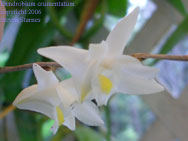
 Hawaiian Tropical Plant Nursery, LLC
Hawaiian Tropical Plant Nursery, LLC
